Evaluation of Enzyme Agarose Gels for Cleaning Complex Substrates in Cultural Heritage
Abstract
:1. Introduction
Research Aims
“When new cleaning solutions are proposed, the conservation scientists are called to test them and assess their effectiveness on mock up samples, prior their application directly on real works of art” [22].
- Tailoring of effective green gels, user-friendly and low cost, avoiding toxic organic solvents.
- Set up of a testing protocol based on an analytical approach to evaluate and compare the cleaning effectiveness of different enzymatic gels.
2. Materials and Methods
2.1. Gel Materials
2.2. Model Samples
- Trypsin on pure rabbit glue (P); binary mixes (PO and PT); ternary mix (POT);
- Lipase on pure linseed oil (O); binary mixes (PO and OT); ternary mix (POT).
2.3. Gels Application
- Calculating the weight loss percentage: after the gel application, swollen material was removed from the samples surface using a two-headed cotton swab, which was bound to a laboratory glass slide of the same thickness as the one used for model samples, and we scrolled it gently five times with the right swab-head and five times with the left one, taking into account the reproducibility of removal of the swollen material (Figure 2). The percentage weight loss value was calculated using the weight value before and after gel application.
- Collecting samples of swollen materials in order to verify the enzymatic hydrolytic action. For this purpose, after the gel application, swollen materials and gels were collected and submitted to freeze-drying using the Savant concentrator. The FTIR analyses (The study of the peaks was carried out with OriginPro 2021. The procedure followed this process: spectrum smoothing with 9 points and applying the Savitzky-Golay method, baseline correction and subtraction set manually with 15 points, tag of the peaks with minimum height > of 10% maximum height) were focused only on a selection of substrates (specimen treated with 2% agarose-fluid-30 min gels), and we considered them the most promising after the collection of weight loss data.
2.4. Evaluation Method and Instrument
2.4.1. Percentage Weight Loss
- Different gels vs. same substrate material (e.g., eight combinations of trypsin gels on the protein–terpene samples);
- Same gel vs. different substrate materials (e.g., 2% agarose, fluid, 10 min gel with trypsin or lipase on different substrates).
2.4.2. FTIR Analysis
3. Result and Discussion
3.1. Specimen Weight Loss
- The weight decrease (%) is quite different with regards to the removed materials; however, there is a recurring trend in the two series of histograms. As can be seen from the figure (Figure 3), pure oil displays variations of a few percentage units, therefore, it could be considered not particularly active; most of the mixes are comprised in the range of a 10–40% weight loss; however, the protein substrate shows some peaks up to 60%.
- For all the substrates, gels applied as a fluid were more effective than the rigid ones. This is probably due to the better gel–substrate contact surface and therefore to a greater release of solution during the application time.
- There is an obvious linear trend between effectiveness and application time: gels applied for 30 min worked better than the corresponding ones applied for 10 min, as we can expect from the fact that the enzymatic activity normally needs a relatively long time to catalyze the hydrolysis of the material.
- Gels with the 2% agarose tend to be more effective than 4% ones. These data can be explained by the fact that hydrolytic enzymes work in an aqueous environment and a minor agarose concentration allows the release of a higher quantity of water to the substrate. Furthermore, a minor agarose concentration leads to a large pores size inside the gel network and easier enzyme circulation. The literature confirms that the most suitable percentages for this type of gel range in concentrations of 1.2–2% [36].
- The removal effectiveness is more influenced by the application time than the agarose concentration. For all substrates, there is a greater difference between two gels with the same agarose concentration and application method, but applied for 10 and 30 min, than between two gels applied in the same way and for the same time, but with different agarose percentages.
3.2. FTIR Spectra Analysis
- (a)
- The intense band at 1650 cm−1 (amide I, C=O peptide bond);
- (b)
- The band around 1540 cm−1 (amide II, C-N peptide bond);
- (c)
- (a)
- The most identifying peaks and bands due to (C-H) CH2 stretching, present in the long chains of fatty acids at 2925 and 2850 cm−1;
- (b)
- (c)
- Other characteristic peaks at 1658, 1464, 1418, 1240, 1164, 723 cm−1 with a further peak at 975cm−1 appearing with aging [59].
3.2.1. Trypsin Gels
3.2.2. Lipase Gels
4. Conclusions
Author Contributions
Funding
Institutional Review Board Statement
Informed Consent Statement
Data Availability Statement
Conflicts of Interest
References
- De Mayerne, T. Ms. Sloane2052, Pictoria, Sculptoria et Quae Subalternarum Atrium; London British Library: London, UK, 1981; pp. 1620–1646. [Google Scholar]
- De Montamy, D. Traité des Coleurs Pour la Peinture en Email et sur la Porcelaine; G. Cavelier: Paris, France, 1765. [Google Scholar]
- De l’Hiberderie, A.N.J. Le Desinate, Pour Les Fabriques D’ettofes d’or, D’argent et de Soie; Chez la Veuve Duchesne; Chez la Veuve Duchesne: Paris, France, 1774. [Google Scholar]
- De Burtin, F.X. Traite Théorique et Pratique des Connaissances, Valenciennes, Lemaitre Libraire—Editeur, 2nd ed.; Lemaitre: Burlington, MA, USA, 1846. [Google Scholar]
- Secco Suardo, G. Il restauratore di Dipinti; Hoepli: Milano, Italy, 1894. [Google Scholar]
- Giannini, C. Lessico del Restauro Storia Tecniche Strumenti; Nardini Editore: Florence, Italy, 1992. [Google Scholar]
- Porcal, E.M. Estudio de Films Adhesivos Aplicados en Tratamientos de Impregnación del Soporte Textil, como Alternativa al Empleo de Materiales Consolidantes en Fase Líquida. Master’s Thesis, University of Valencia, Valencia, Spain, 2012–2013. [Google Scholar]
- Morlotti, M. Una “Malaugurata Costumanza”: Il Restauro di un Dipinto su Tela di Giuseppe Vermiglio e Approfondimento sul “Cosidetto Beverone ed altri Consimili Imbratti”; Restauro in Accademia Milano, Volume secondo; Edifir: Florence, Italy, 2023. [Google Scholar]
- Burnstock, A.; White, R. The effects of selected solvents and soaps on a simulated canvas painting. In Cleaning Retouching and Coatings. Technology and Practice for Easel Paintings and Polychrome Sculpture, Preprints of the Contributions to Brussels Congress, IIC, London; International Institute for Conservation of Historic and Artistic Works: London, UK, 1990; pp. 111–118. [Google Scholar]
- Erhrdt, D.; Bishoff, J. The role of various, components of Resin Soaps, bile acid soaps and gels, and their effect on oil paint films. Stud. Conserv. 1994, 39, 3–27. [Google Scholar]
- Erhardt, D.; Bischoff, J. Resin Soaps and Solvents in the Cleaning of Paintings: Similarities and Differences. In Proceedings of the ICOM Committee for Conservation 10th Triennial Meeting, Washington, DC, USA, 20–27 August 1993. [Google Scholar]
- Dickinson, E.; Bergenstähl, B. Food Colloids. Proteins, Lipids and Polysaccharides; The Royal Society of Chemistry: Cambridge, UK, 1997. [Google Scholar]
- Whistler, R.L.; BeMiller, J.N. Industrial Gums: Polysaccharides and Their Derivatives, 3rd ed.; Academic Press, Inc.: San Diego, CA, USA, 1993; 642p, ISBN 0-12-746253-8. [Google Scholar]
- Allistair, S.M.; Glyn, P.O.; Peter, W.A. Food Polysaccharides and Their Applications; CRC Press: Boca Raton, FL, USA, 1922. [Google Scholar] [CrossRef]
- Ramirez Barat, B.; Cano, E. Agar versus Agarose Gelled Electrolyte for In Situ Corrosion Studies on Metallic Cultural Heritage. ChemElectroChem 2019, 6, 2553–2559. [Google Scholar] [CrossRef]
- Gustavsson, E.; Larsson, O. Chapter 6—Monolithic Polysaccharide Materials. J. Chromatogr. Libr. 2003, 67, 121–141. [Google Scholar] [CrossRef]
- Weyer, A.; Roig Picazo, P.; Pop, D.; Cassar, J.; Özköse, A.; Vallet, J.M.; Srša, I. EwaGlos-European Illustrated Glossary of Conservation Terms for Wall Paintings and Architectural Surfaces; English Definitions with Translations into Bulgarian, Croatian, French, German, Hungarian, Italian, Polish, Romanian, Spanish and Turkish; The Hornemann Institute: Hildesheim, Germany, 2015. [Google Scholar] [CrossRef]
- Ranalli, G.; Zanardini, E. Biocleaning on Cultural Heritage: New frontiers of microbial biotechnologies. J. Appl. Microbiol. 2021, 131, 583–603. [Google Scholar] [CrossRef] [PubMed]
- Heselmeyer, K.; Fischer, U.; Krumbein, W.E.; Warscheid, T. Application of Desulfovibrio vulgaris for the bioconversion of rock gypsum crusts into calcite. BIOforum 1991, 1, 89. [Google Scholar]
- Cappitelli, F.; Toniolo, L.; Sansonetti, A.; Gulotta, D.; Ranalli, G.; Zanardini, E.; Sorlini, C. Advantages of using microbial technology over traditional chemical technology in removal of black crusts from stone surfaces of historical monuments. Appl. Environ. Microbiol. 2007, 73, 5671–5675. [Google Scholar] [CrossRef]
- Ranalli, G.; Alfano, G.; Belli, C.; Lustrato, G.; Colombini, M.P.; Bonaduce, I.; Zanardini, E.; Abbruscato, P.; Cappitelli, F.; Sorlini, C. Biotechnology applied to cultural heritage: Biorestoration of frescoes using viable bacterial cells and enzyme. J. Appl. Microbiol. 2004, 98, 73–83. [Google Scholar] [CrossRef]
- Hrdlickova Kuckova, S.; Crhova Krizkova, M.; Pereira, C.L.C.; Hynek, R.; Lavrova, O.; Busani, T.; Branco, L.C.; Sandu, I.C.A. Assessment of green cleaning effectiveness on polychrome surfaces by MALDI-TOF mass spectrometry and microscopic imaging. Microsc. Res. Tech. 2014, 77, 574–585. [Google Scholar] [CrossRef]
- Aucouturier, M.; Darque-Ceretti, E. The surface of cultural heritage artefacts: Physicochemical investigations for their knowledge and their conservation. Chem. Soc. Rev. 2007, 36, 1605–1621. [Google Scholar] [CrossRef]
- Lorusso, S.; Natali, A.; Matteucci, C. Colorimetry applied to the field of cultural heritage: Examples of study cases. Conserv. Sci. Cult. Herit. 2007, 7, 187–220. [Google Scholar]
- DeCruz, A.; Wolbarsht, M.L.; Andreotti, A.; Colombini, M.P.; Pinna, D.; Culberson, C.F. Investigation of Er:YAG laser at 2.94 μm to remove lichens growing on stones. Stud. Conserv. 2009, 54, 268–277. [Google Scholar] [CrossRef]
- Sandu, I.C.; Bracci, S.; Lobefaro, M.; Sandu, I. Integrated methodology for the evaluation of cleaning effectiveness in two Russian icons (16th–17th centuries). Microsc. Res. Tech. 2010, 73, 8. [Google Scholar] [CrossRef]
- Pruteanu, S.; Vasilache, V.; Sandu, I.C.; Budu, A.M.; Sandu, I. Assessment of cleaning effectiveness for new ecological systems on ancient tempera icon, by complementary microscopic technique. Microsc. Res. Tech. 2014, 77, 12. [Google Scholar] [CrossRef] [PubMed]
- Schreiner, M.; Melcher, M.; Uhlir, K. Scanning electron microscopy and energy dispersive analysis: Applications in the field of cultural heritage. Anal. Bioanal. Chem. 2007, 387, 737–747. [Google Scholar] [CrossRef] [PubMed]
- Van den Berg, K.J.; Daudin, M.; Joosten, I.; Wei, B.; Morrison, R.; Burnstock, A. A comparison of light microscopy techniques with scanning electron microscopy for imaging the surface cleaning of painting. In Proceedings of the 9th International Conference on NDT of Art, Jerusalem, Israel, 25–30 May 2008. [Google Scholar]
- Bellucci, R.; Cremonesi, P. L’uso degli enzimi nella conservazione e nel restauro dei dipinti. Kermes 1994, 21, 45–64. [Google Scholar]
- Cremonesi, P.; Bellucci, R.; Pignagnoli, G. A note on the use of enzymes in conservation. A preliminary report on the removal of aged acrylic resin coating with Lipase. Stud. Conserv. 1999, 44, 278–281. [Google Scholar]
- Wolbers, R.C. Aspects of the examination and cleaning of two portraits by Richard and William Jennys. In Proceedings of the AIC 16th Annual Meeting, New Orleans, LA, USA, 1–5 June 1988; pp. 245–260. [Google Scholar]
- Cremonesi, P. L’uso Degli Enzimi Nella Pulitura di Opere Policrome; Il Prato: Padova, Italy, 2002. [Google Scholar]
- Wolbers, R.C. Notes for Workshop on New Methods in the Cleaning of Painting; Getty Conservation Institute: Los Angeles, CA, USA, 1990. [Google Scholar]
- Wolbers, R.C. Cleaning Painted Surfaces. Aqueous Method; Archetype Publication: London, UK, 2003. [Google Scholar]
- van Dyke, Y. Agarose Enzyme Gels in Paper Conservation, Gels in Conservation; Archetype Publication: London, UK, 2017. [Google Scholar]
- Müller, W. Reduction of Extensive Protein Staining with Enzymatic Gel Sheets Treatment of a Pen and Ink Drawing with Watercolor from 1755. J. Pap. Conserv. 2015, 16, 133–137. [Google Scholar] [CrossRef]
- Ferrari, M. Una tunica del museo egizio di Torino: Sperimentazione di nuove tecniche di pulitura e di consolidamento. In XII Congresso Nazionale IGIIC, Lo Stato dell’Arte, Accademia Di Belle Arti di Brera 2014; Nardini: Florence, Italy, 2014. [Google Scholar]
- Wendelbo, O.; Fosse, B. Protein “surgery”. A restoring procedure applied on paper. Restaurator 1970, 1, 245–248. [Google Scholar] [CrossRef]
- Wendelbo, O. The freeing of papyri from cartonnage. Restaurator 1975, 2, 41–52. [Google Scholar] [CrossRef]
- Cremonesi, P.; Signorini, E. Un Approccio Alla Pulitura dei Dipinti Mobili; Il Prato: Padua, Italy, 2016. [Google Scholar]
- Cremonesi, P. L’ambiente Acquoso per il Trattamento di Opere Policrome; Il Prato: Padua, Italy, 2012; pp. 32–33. [Google Scholar]
- Campani, E. L’Uso di Agarosio e Agar per la preparazione di Gel Rigidi, Quaderni del Cesmar7, n. 4; Il Prato: Padua, Italy, 2007. [Google Scholar]
- Anzani, M.; Berzioli, G.; Riggiardi, D.; Rabbolini, A. Gel Rigidi di Agar per il Trattamento di Pulitura di Manufatti in Gesso, Quaderni del Cesmar7, n.6; Il prato: Padua, Italy, 2008. [Google Scholar]
- Giordano, A.; Cremonesi, P. Gel Rigidi Polisaccaridici per il Trattamento di Manufatti Artistici; Il prato: Padua, Italy, 2019. [Google Scholar]
- Sansonetti, A.; Bertasa, M.; Canevali, C.; Rabbolini, A.; Anzani, M.; Scalarone, D. A review in using agar gels for cleaning art surfaces. J. Cult. Herit. 2020, 44, 285–296. [Google Scholar] [CrossRef]
- Bertasa, M. Investigation of Agar Gels for Cleaning Artworks: Composition, Structure, Properties and Cleaning Mechanisms. Ph.D. Thesis, Chemical and Material Science, XXX Ciclo, University of Turin, Turin, Italy, 2017. [Google Scholar]
- Selva Bonino, V.E. Studio Preliminare di Gel Rigidi a Base di Agarosio per il Trattamento Conservativo dei Dipinti Murali. Master’s Thesis, Scienze e Tecnologie per la Conservazione e il Restauro dei Beni Culturali, Parma University, Parma, Italy, 2007/2008. [Google Scholar]
- Bertasa, M.; Canevali, C.; Sansonetti, A.; Lazzari, M.; Malandrino, M.; Simonutti, R.; Scalarone, D. An in-depth study on the agar gel effectiveness for built heritage cleaning. J. Cult. Herit. 2021, 47, 12–20. [Google Scholar] [CrossRef]
- Martinelle, M. On the interfacial activation of Candida antarctica lipase A and B as compared with Humicola lanuginosa lipase. Biochim. Biophys. Acta 1995, 1258, 272–276. [Google Scholar] [CrossRef] [PubMed]
- Verger, R.; De Haas, G.H. Interfacial enzyme kinetics of lipolysis. Annu. Rev. Biophys. Bioeng. 1976, 5, 77–117. [Google Scholar] [CrossRef] [PubMed]
- Stani, C.; Vaccari, L.; Mitri, E.; Birarda, G. FTIR investigation of the secondary structure of type I Collagen: New insight in to the amide III band. Spectrochim. Acta Part A Mol. Biomol. Spectrosc. 2020, 229, 118006. [Google Scholar] [CrossRef] [PubMed]
- Pellegrini, D.; Duce, C.; Bonaduce, I.; Biagi, S.; Ghezzi, L.; Colombini, M.P.; Tinè, M.R.; Bramanti, E. Fourier transform infrared spectroscopic study of rabbit glue/inorganic pigments mixtures in fresh and aged reference paint reconstruction. Microchem. J. 2016, 124, 31–35. [Google Scholar] [CrossRef]
- De Campos Vidal, B.; Mello, M.L.S. Collagen type I amide I band infrared spectroscopy. Micron 2011, 42, 283–289. [Google Scholar] [CrossRef]
- Muyonga, J.H.; Cole, C.G.B.; Duodu, K.G. Characterisation of acid soluble collagen from skins of adult and young Nile perch (Lates niloticus). Food Chem. 2004, 85, 81–89. [Google Scholar] [CrossRef]
- Lewinska, A.; Zebrowski, J.; Duda, M.; Gorka, A.; Wnuk, M. Fatty Acid Profile and Biological Activities of Linseed and Rapeseed Oils. Molecules 2015, 20, 22872–22880. [Google Scholar] [CrossRef]
- Bouyanfif, A.; Liyanage, S.; Hequet, E.; Moustaid-Moussa, N.; Abidi, N. FTIR microspectroscopy reveals fatty acid-induced biochemical changes in C. elegans. Vib. Spectrosc. 2019, 102, 8–15. [Google Scholar] [CrossRef]
- Ibrahim, M.; Nada, A.; Kamal, D.E. Density functional theory and FTIR spectroscopic study of carboxyl group. Indian J. Pure Appl. Phys. 2005, 43, 911–917. [Google Scholar]
- Lazzari, M.; Chiantore, O. Drying and oxidative degradation of linseed oil. Polym. Degrad. Stab. 1999, 65, 303–313. [Google Scholar] [CrossRef]
- Font, J.; Salvadó, N.; Butí, S.; Enrich, J. Fourier transform infrared spectroscopy as a suitable technique in the study of the materials used in waterproofing, of archaeological amphorae. Anal. Chim. Acta 2007, 598, 119–127. [Google Scholar] [CrossRef] [PubMed]
- Kristoffersen, K.A.; Liland, K.H.; Böcker, U.; Wubshet, S.G.; Lindberg, D.; Horn, S.J.; Afseth, N.K. FTIR-based hierarchical modelling for prediction of average molecular weights of protein hydrolysates. Talanta 2019, 205, 120084. [Google Scholar] [CrossRef] [PubMed]
- Güler, G.; Vorob’ev, M.M.; Vogel, V.; Mäntele, W. Proteolytically induced changes of secondary structural protein conformation of bovine serum albumin monitored by Fourier transform infrared (FT-IR) and UV-circular dichroism spectroscopy. Spectrochim. Acta Part A Mol. Biomol. Spectrosc. 2016, 161, 8–18. [Google Scholar] [CrossRef] [PubMed]
- Bamdad, F.; Wu, J.; Chen, L. Effect of enzymatic hydrolysis on molecular structure and antioxidant activity of barley hordein. J. Cereal Sci. 2011, 54, 20–28. [Google Scholar] [CrossRef]
- Lievens, C.; Mourant, D.; He, M.; Gunawan, R.; Li, X.; Li, C.Z. An FT-IR spectroscopic study of carbonyl functionalities in Bio-oil. Fuel 2011, 90, 3417–3423. [Google Scholar] [CrossRef]
- Khaskheli, A.A.; Talpur, F.N.; Ashraf, M.A.; Cebeci, A.; Jawaid, S.; Afridi, H.I. Monitoring the Rhizopus oryzae lipase catalyzed hydrolysis of castor oil by ATR-FTIR spectroscopy. J. Mol. Catal. B Enzym. 2015, 113, 56–61. [Google Scholar] [CrossRef]
- Wang, Q.; Sanad, W.; Miller, L.M.; Voigt, A.; Klingel, K.; Kandolf, R.; Stangl, K.; Baumann, G. Infrared imaging of compositional changes in inflammatory cardiomyopathy. Vib. Spectrosc. 2005, 38, 217–222. [Google Scholar] [CrossRef]
- Dean, A.P.; Sigee, D.C.; Estrada, B.; Pittman, J.K. Using FTIR spectroscopy for rapid determination of lipid accumulation in response to nitrogen limitation in freshwater Microalgae. Bioresour. Technol. 2010, 101, 4499–4507. [Google Scholar] [CrossRef]
- Tsai, J.C.; Lo, Y.L.; Lin, C.Y.; Sheu, H.M.; Lin, J.C. Feasibility of rapid quantitation of stratum corneum lipid content by Fourier transform infrared spectrometry. Spectroscopy 2004, 18, 423–431. [Google Scholar] [CrossRef]
- O’Hoski, B.A. An Investigation into the Composition and Properties of Saliva in Relation to the Surface Cleaning of Oil Painting, Ottawa Regional Group Meeting; National Gallery of Canada: Ottawa, ON, Canada, 1976. [Google Scholar]
- Banik, A. The application of CarbopolTM gels and enzymes containing Methylcellulose gels for removal of starch based adhesives in albums. In Proceedings of the International Conference on Conservation and Restoration of Archive and Library materials, Erice, ICPL, X/ 7, Roma, Erice, Italy, 22–29 April 1996. [Google Scholar]
- Dea, I.C.M. Industrial polysaccharides. Pure Appl. Chem. 1989, 61, 1315–1322. [Google Scholar] [CrossRef]
- Modugno, F.; Di Gianvincenzo, F.; Degano, I.; van der Werf, I.D.; Bonaduce, I.; van den Berg, K.J. On the influence of relative humidity on the oxidation and hydrolysis of fresh and aged oil paints. Sci. Rep. 2019, 9, 5533. [Google Scholar] [CrossRef] [PubMed]
- Canevari, C.; Malagodi, M.; Merlo, C.; Albano, M.; Invernizzi, C.; Rovetta, T.; Fiocco, G. Le Vernici Storiche di Strumenti Musicali: Un Percorso di Ricerca, Produzione, Diagnostica e Formazione, Lo Stato Dell’arte 18; Nardini editore: Florence, Italy, 2020. [Google Scholar]
- Ramachandran, G.N. Modification of collagen and gelatin by chemical reagents. In Recent Advances in Gelatin and Glue Research; Stainsby, G., Ed.; Pergamon Press: London, UK; New York, NY, USA, 1957. [Google Scholar]
- Saccani, I. Studio per L’applicazione di α-Amilasi in gel di Agar per la Rimozione di Colle Amilacee da Supporti Cartacei. Master’s Thesis, Università di Parma, Parma, Italy, 2009. [Google Scholar]
- Haug, I.J.; Draget, K.I.; Smidsrød, O. Physical and rheological properties of fish gelatin compared to mammalian gelatin. Food Hydrocoll. 2004, 18, 203–213. [Google Scholar] [CrossRef]
- Segal, J.; Cooper, D. The use of enzymes to release adhesives. Pap. Conserv. 1977, 2, 47–50. [Google Scholar] [CrossRef]
- Eastoe, J.E. The Amino Acid Composition of Mammalian Collagen and Gelatin. Biochem. J. 1955, 61, 589. [Google Scholar] [CrossRef]
- Neugebauer, J.M. Detergents: An Overview. In Guide to Protein Purification (Methods in Enzymology Vol. 182); Deutscher, M.P., Ed.; Academic Press: San Diego, CA, USA, 1990. [Google Scholar]
- Mills, J.S.; White, R. The Organic Chemistry of Museum Object; Butterworths: Oxford, UK, 1987. [Google Scholar]
- Hatton, M. Enzymes in a viscous medium. Pap. Conserv. 1977, 2, 9. [Google Scholar] [CrossRef]
- Morlotti, M. Il restauro del dipinto su tela ‘San Paolo’ di Giuseppe Vermiglio del Museo di Sant’Eustorgio a Milano. Master’s Thesis, Accademia di Brera, Milano A.A., Milano, Italy, 2020/2021. [Google Scholar]
- Makes, F. Enzymatic consolidation of a painting: Seventeenth century landscape from Skokloster Palace. Stud. Conserv. 1982, 27, 25–30. [Google Scholar] [CrossRef]
- Makes, F. Enzymatic Consolidation of Painting; University of Goteborg: Gothenburg, Sweden, 1979. [Google Scholar]
- Makes, F. Enzymatic Consolidation of the Portrait of Rudolf II with a Multi-Enzyme Preparation Isolated from Antartic krill, Goteborg Studies on Conservation 1; Acta Universitatis Gothoburgensis, Goteborg: Gothenburg, Sweden, 1988. [Google Scholar]
- Members of the GMIA. Gelatin Handbook; GMIA: New York, NY, USA, 2012. [Google Scholar]
- Schellmann, N.C. Animal glues: A review of their key properties relevant to conservation. Stud. Conserv. 2007, 52, 55–66. [Google Scholar] [CrossRef]
- Cremonesi, P. Rigid Gels and Enzyme Cleaning. In Gels in Conservation; Archetype Publication: London, UK, 2017. [Google Scholar]
- Cremonesi, P. Tensioattivi e Chelanti per il Trattamento di Opere Policrome; Il Prato: Padua, Italy, 2021. [Google Scholar]
- Larminie, P. The Use of Enzymes for the Removal of Oil Stains from Paper, Conference Papers, Manchester; The Institute of Paper Conservation: London, UK, 1992. [Google Scholar]
- Armisién, R.; Galatas, F. Agar. In Handbook of Hydrocolloids; Phillips, G.O., Williams, P.A., Eds.; CRC Press: Boca Raton, FL, USA, 2000; pp. 22–40. [Google Scholar]
- Bonomi, R. L’applicazione degli enzimi al restauro delle opere lignee, corso “Le metodologie enzimatiche per la pulitura e il restauro delle opere d’arte”, Villa Gualino, Torino. Personal Communication, 2000. [Google Scholar]
- Mayne, R.; Burgeson, R.E. Structure and Function of Collagen Types; Academic Press. Inc: Cambridge, MA, USA, 1987. [Google Scholar]
- Markevičius, T.; Syversen, T.; Chan, E.; Olsson, N.; Skov, C. Cold, warm, warmer: Use of precision heat transfer in the optimization of hydrolytic enzyme and hydrogel cleaning systems. In Gels in Conservation; Archetype: London, UK, 2017. [Google Scholar]
- Villavecchia, V.G.; Eigenmann, G. Nuovo Dizionario di Merceologia e Chimica Applicate; Hoepli: Milano, Italy, 1977. [Google Scholar]
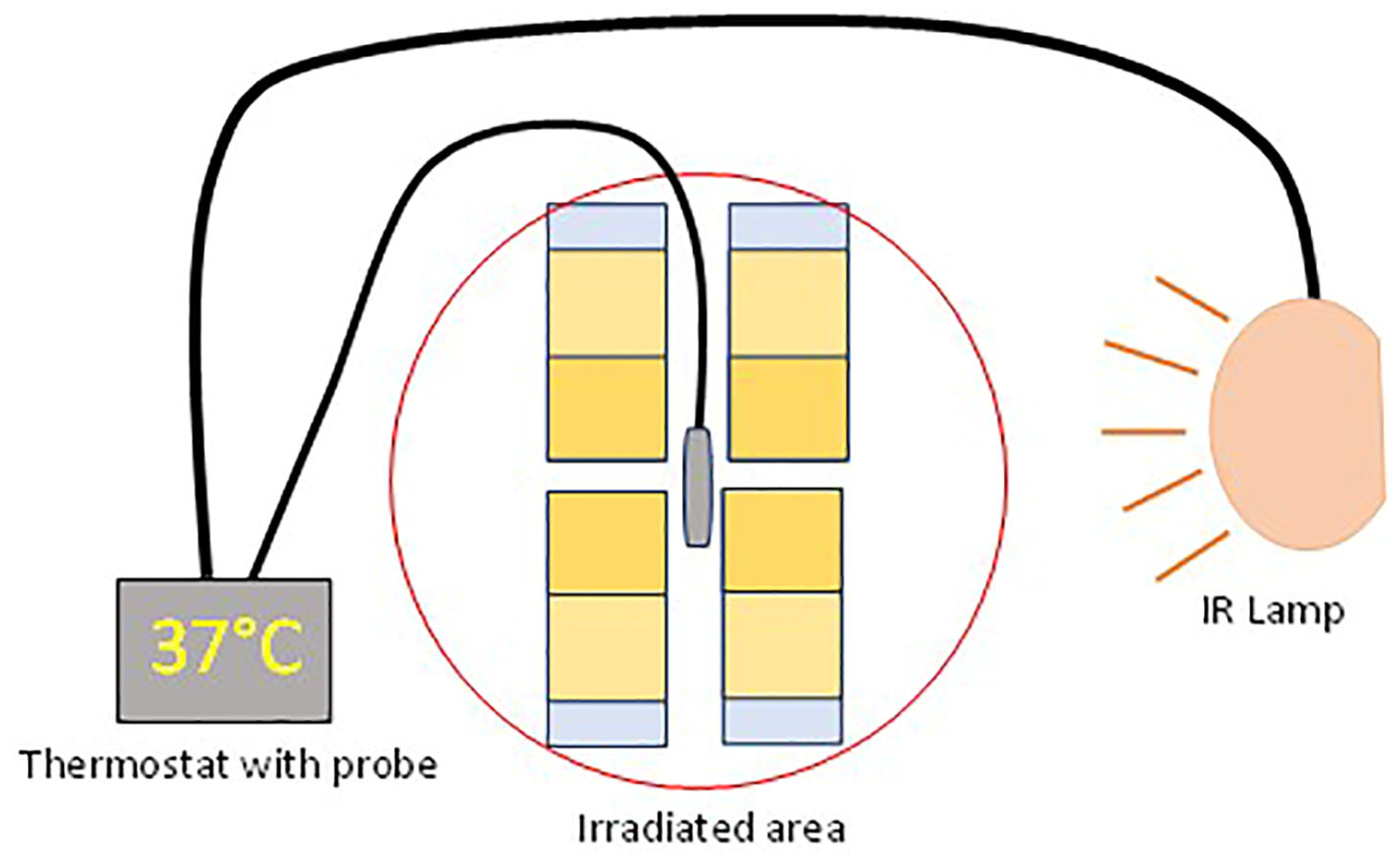
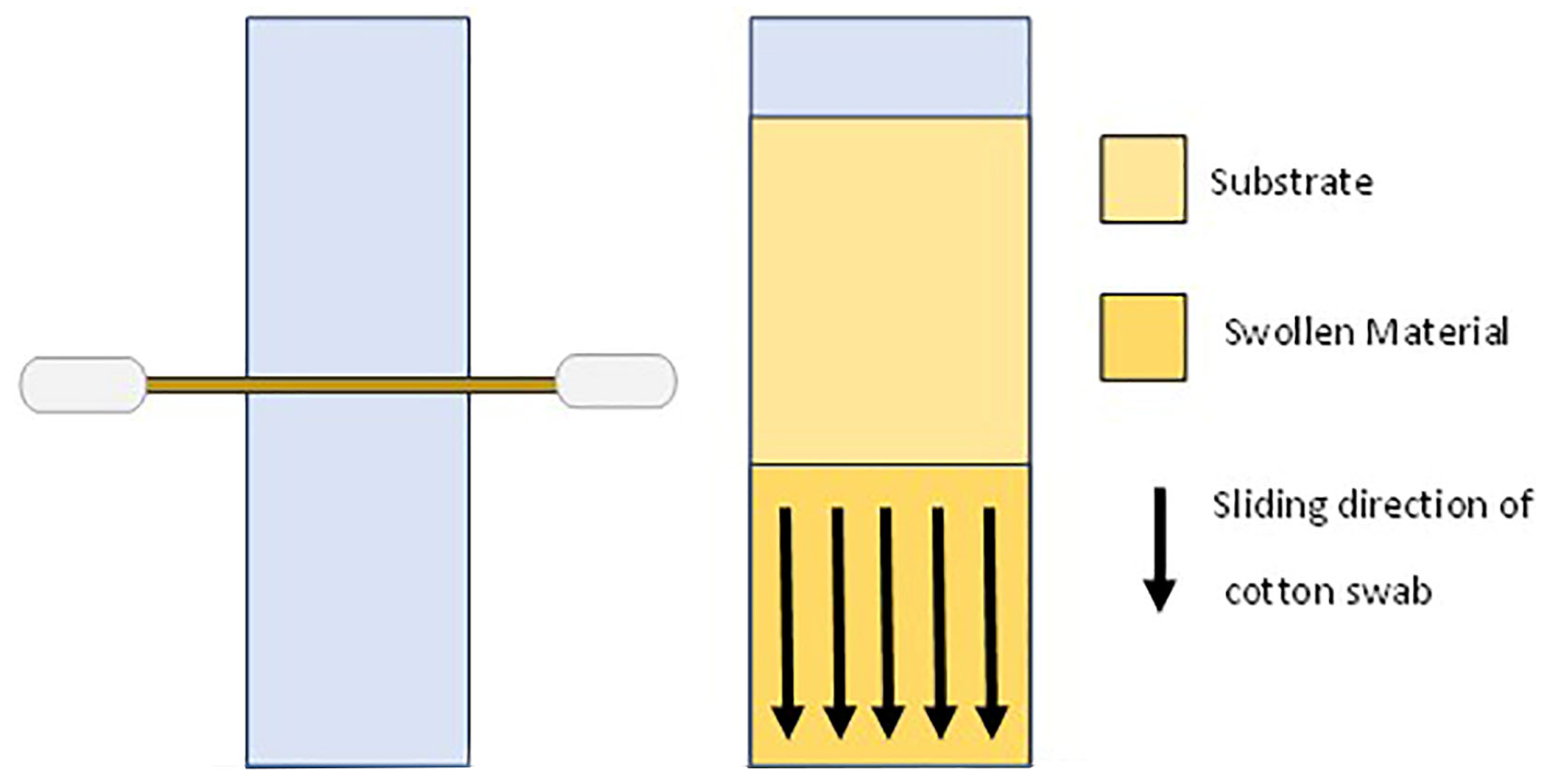

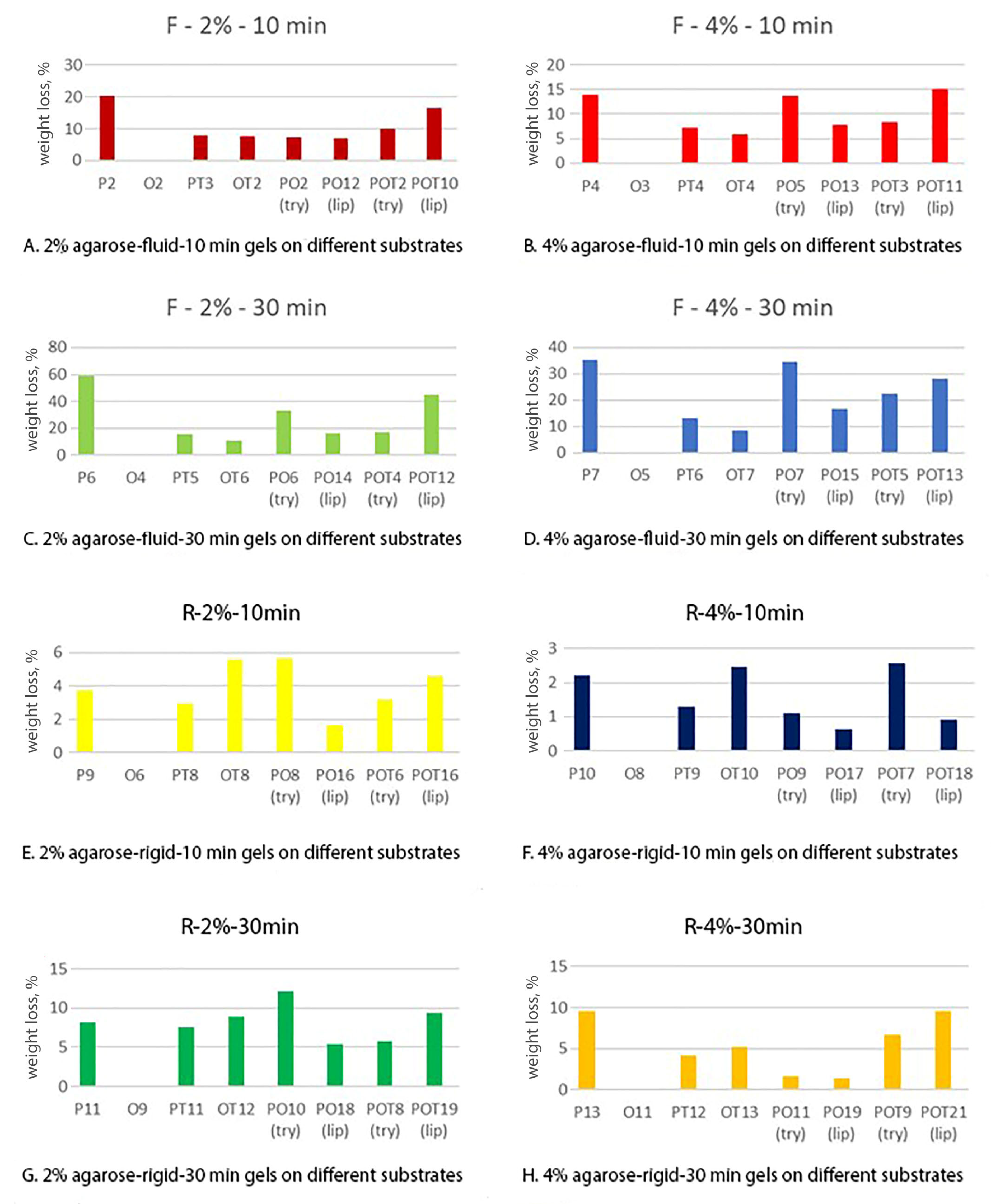
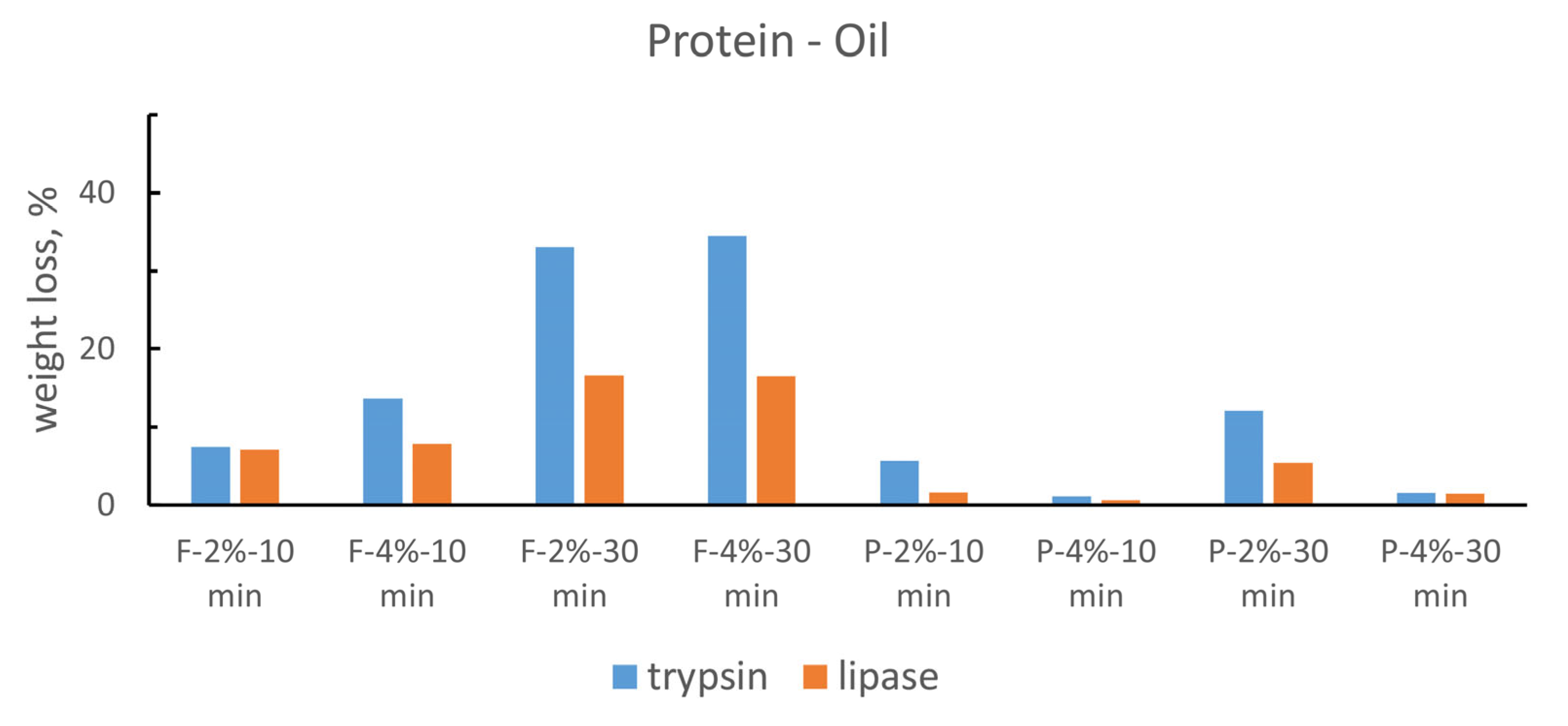
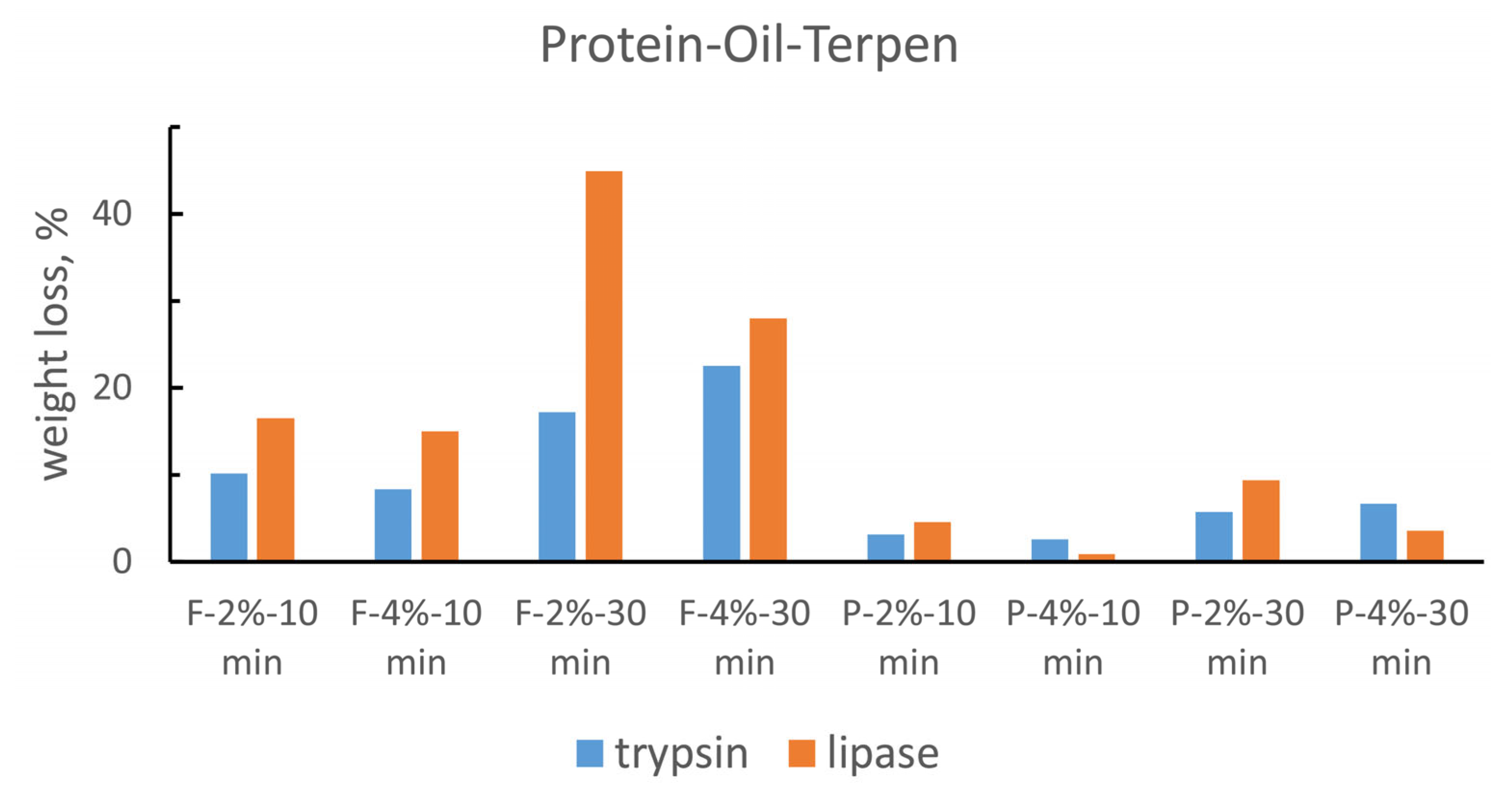

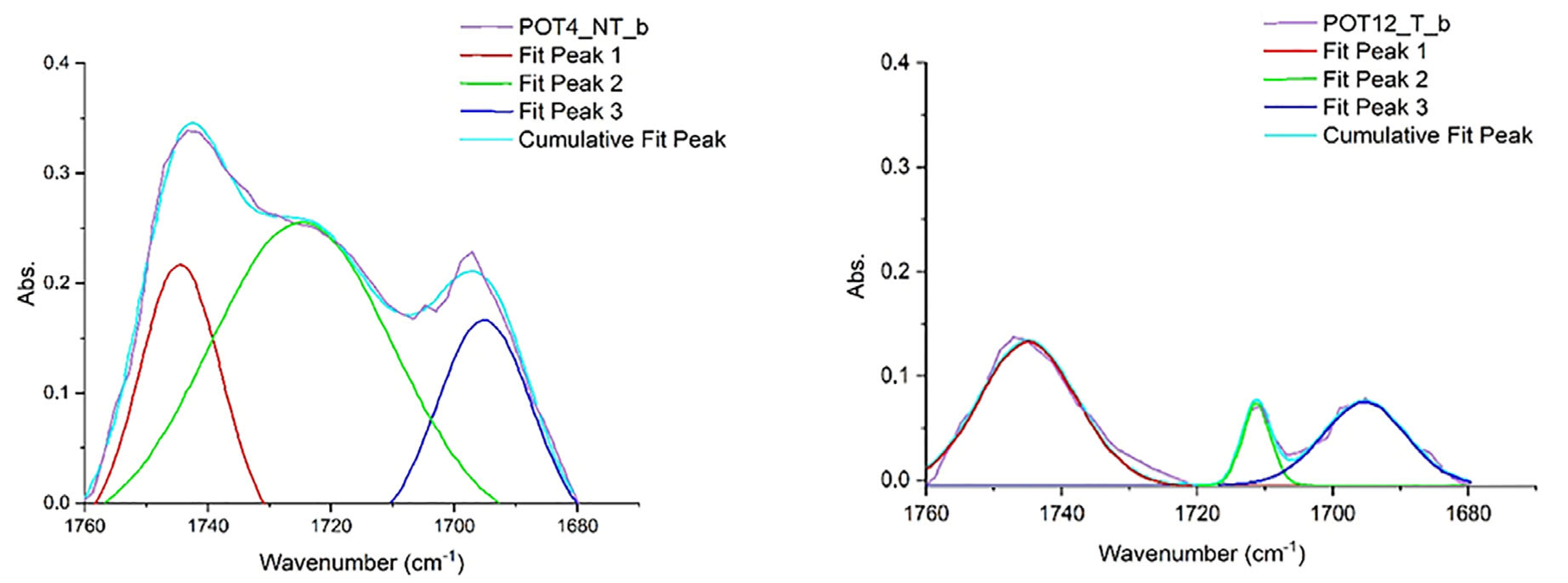
| Enzyme | Method of Application | Time of Application | Agarose Concentration | Labelling |
|---|---|---|---|---|
| Trypsin - Lipase | Fluid | 10 min | 2% | F-2%-10 min |
| 4% | F-4%-10 min | |||
| 30 min | 2% | F-2%-30 min | ||
| 4% | F-4%-30 min | |||
| Rigid | 10 min | 2% | R-2%-10 min | |
| 4% | R-4%-10 min | |||
| 30 min | 2% | R-2%-30 min | ||
| 4% | R-4%-30 min |
| Specimen Material | Name of Series | Enzyme Tested | N. of Replicas |
|---|---|---|---|
| Rabbit skin glue | P (protein) | Trypsin | 8 |
| Linseed oil | O (oil) | Lipase | 8 |
| Colophony | T (terpenic) | - | 8 |
| Rabbit Glue + Colophony | PT | Trypsin | 8 |
| Linseed oil + Colophony | OT | Lipase | 8 |
| Rabbit Glue + Linseed oil | PO | Trypsin–Lipase | 16 |
| Glue + Oil + Colophony | POT | Trypsin–Lipase | 16 |
| Lipase Gel | Trypsin Gel |
|---|---|
| 0.25 g of lipase in 15mL of DCA-TEA solution | 0.01 g of trypsine in 1mL of 1mM HCl solution |
| 35 mL of DCA-TEA solution with agarose | 49 mL of DCA-TEA solution with agarose |
| Concentration: 5 mg/mL–3500 U/mL | Concentration: 0.2 mg/mL–400 U/mL |
Disclaimer/Publisher’s Note: The statements, opinions and data contained in all publications are solely those of the individual author(s) and contributor(s) and not of MDPI and/or the editor(s). MDPI and/or the editor(s) disclaim responsibility for any injury to people or property resulting from any ideas, methods, instructions or products referred to in the content. |
© 2023 by the authors. Licensee MDPI, Basel, Switzerland. This article is an open access article distributed under the terms and conditions of the Creative Commons Attribution (CC BY) license (https://creativecommons.org/licenses/by/4.0/).
Share and Cite
Morlotti, M.; Forlani, F.; Saccani, I.; Sansonetti, A. Evaluation of Enzyme Agarose Gels for Cleaning Complex Substrates in Cultural Heritage. Gels 2024, 10, 14. https://doi.org/10.3390/gels10010014
Morlotti M, Forlani F, Saccani I, Sansonetti A. Evaluation of Enzyme Agarose Gels for Cleaning Complex Substrates in Cultural Heritage. Gels. 2024; 10(1):14. https://doi.org/10.3390/gels10010014
Chicago/Turabian StyleMorlotti, Mattia, Fabio Forlani, Ilaria Saccani, and Antonio Sansonetti. 2024. "Evaluation of Enzyme Agarose Gels for Cleaning Complex Substrates in Cultural Heritage" Gels 10, no. 1: 14. https://doi.org/10.3390/gels10010014





